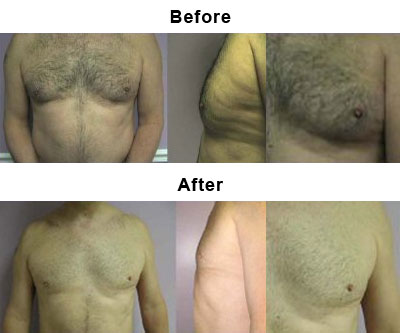Gynocomastia
Correction of gynecomastia is the most popular cosmetic procedure with men and is usually covered by insurance. Most men get some gynecomastia (fat accumulation around the breast) with middle age. Working out with weights may reduce, but not eliminate, gynecomastia because the main of gynecomastia is fatty production around the male breast per se-not loss of muscle mass.
Gynecomastia surgery, is liposuction and/or excision of extra fat from the male breast. Some men elect to have fat transfer into the pectoralis muscle or pectoralis muscle implants, so as to give a more sculpted look. Pectoralis implants and/or fat sculpting is not covered by insurance.
(Male Breast Reduction)

Most middle aged men have some gynecomastia. There are many reasons for this, but men who eat a lot of red meat are typically consuming hormone treated cows, which causes gynecomastia in men. If it makes the cow fat, it makes people fat.
Also age, weight gain, and alcohol consumption contribute to gynecomastia.
Gynecomastia surgery has three options:
- Mild gynecomastia may be treated with liposuction only. This is a good option if the amount of excess skin is not excessive. Recovery is immediate and the patient may return to work in 1-2 days. Liposuction of male breasts costs $2,500, but is usually covered by insurance.
- Moderate or severe gynecomastia needs liposuction of the fat and excision of extra skin (partial mastectomy). The cost for this is $6,000, but is almost always covered by insurance. With matectomy, there will be a small scar around the nipple, which will be nearly invisible after it heals.
- An alternative to liposuction and mastectomy for moderate-severe gynecomastia is liposuction and pectoaralis implants. If the amount of gynecomastia is great, liposuction would cause flabby skin around the breast. Weight lifting could build up the muscle to fill this in, or implants may be used to fill the loose skin immediately. Implants may be placed without a nipple incision and are more cosmetic than mastectomy. The abscence of a nipple incision (seen with partial mastectomy) is an advantage of implants, but implants are not covered by insurance.
Liposuction and pectoralis implantation cost $8,500 less whatever the insurance company pays for liposuction of the breasts.